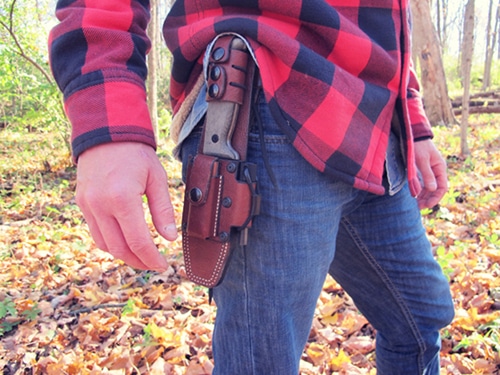
With our archives now 3,500+ articles deep, we’ve decided to republish a classic piece each Friday to help our newer readers discover some of the best, evergreen gems from the past. This article was originally published in November 2011.
This is a guest post from wilderness survival expert and instructor Creek Stewart.
I don’t remember my first kiss or even who it was with. I can barely recollect getting my license to drive. I vaguely remember my high school graduation and my entire time spent at college is a blur. However, I remember exactly where I was, what I was wearing, and how I felt when I got my first survival knife over 20 years ago. Just thinking about it brings back some of my fondest childhood memories. It was the RAMBO knife with the hollow handle that housed a little fishing kit along with a few other miscellaneous items. My love affair with knives began at a young age, and I’ve been hooked ever since. Movies seem to always have the coolest survival knives, but does the survival knife really have a place in the “real world”?
That was a rhetorical question. Yes, it most certainly does.
Despite our advancements in medicine, technology, travel, and communications, millions of people across the globe face disaster and its merciless consequences each year. In addition, thousands of individuals are thrust into unexpected and unpredictable life or death situations where survival depends on experience, knowledge, and the resources on hand. My point? It is wise to keep important survival resources close by — just in case. One of your most important survival tools is a quality knife.
The cutting blade has carved itself an indispensable place in survival history. For thousands of years, man has depended on a cutting tool of some kind to help meet basic survival needs: food, water, fire, and shelter. Now, in our modern society, we casually refer to this blade as the “survival knife.” It has certainly earned that name. However, not all survival knives are created equal.
I have the privilege of strapping a survival knife to my hip on almost a daily basis here at Willow Haven. I completely understand, though, that this isn’t practical for most. At a minimum, a survival knife should be kept accessible. You might be surprised how often you’ll use it — even if not in a survival situation. I never travel without my survival knife. I pack it in my checked baggage on the plane. I keep it on my hotel nightstand. It’s always in the console of my truck when road-tripping, and I never set off for an adventure without it. Whether fishing, backpacking, hunting, boating, skiing, hiking, or camping, my knife is a trusted companion. I’m rarely more than a stone’s throw away from it at any given moment.
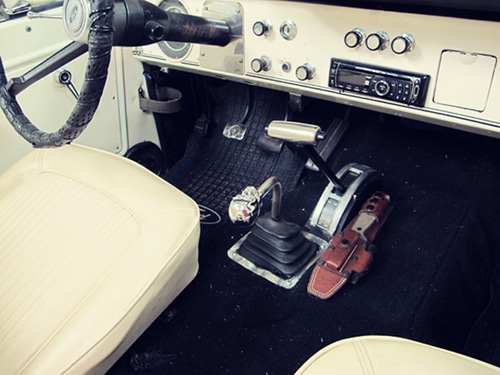
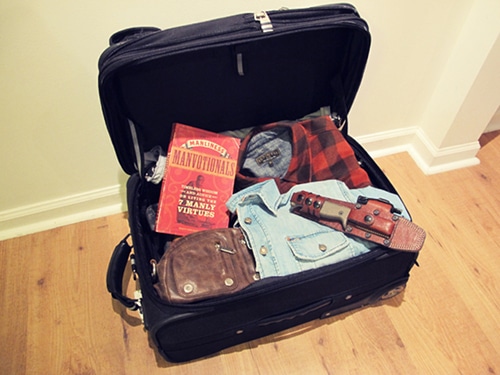
A “survival knife” is just as it sounds — a knife that can help you survive. It is a tool with literally hundreds of survival-related functions. Below is a short list:
- Cutting/slicing
- Digging
- Splitting
- Self-defense
- First aid tool
- Food prep
- Shelter building
- Fire making
- Hunting weapon
- Prying tool
- Signaling
- Hammering
- Makeshift screwdriver
When it comes to your survival knife, less is typically more — despite what you may see on TV. Hang the cool movie prop knife on a wall and embrace the simplicity of a skillfully designed survival knife. Function trumps styling — always. Your first priority is performance and that will depend on a variety of time-tested key features.
6 Important Survival Knife Features
Survival Knife Feature #1: Size
Does size matter? Yes, but when it comes to your survival knife, bigger is not always better. If your blade is too big, you sacrifice the ability to effectively use it for detailed tasks such as dressing small game or carving precision snare sets.
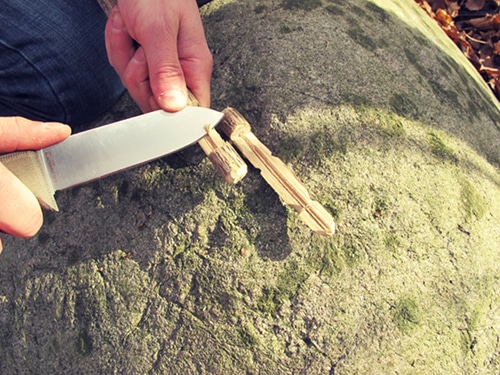
On the flip-side, a small blade does not perform well with more rugged tasks such as batoning and chopping. Batoning is when you strike the back of your knife blade with a heavy object to drive the knife through thick or stubborn wood. This allows the blade to be used for splitting wood and cutting through large limbs and trees.
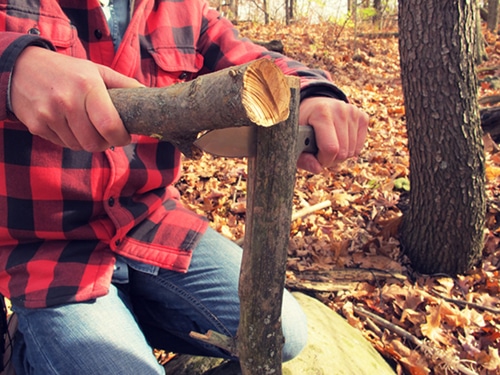
Having used many survival knives, I’ve found the ideal size to be around 9-11 inches in length. For example, my Blackbird SK-5 survival knife pictured below is 10†in OVERALL length with a 5†blade.

Survival Knife Feature #2: Fixed Blade
A fixed blade knife is more durable and reliable than a folding knife. While I love a good folder for Every Day Carry (EDC), a fixed blade has the upper hand when it comes to meeting the demands a survival situation might present.

A joint of any kind is a weakness. Minimize the risk of damaging or losing your key survival resource by choosing a knife that is better suited for pounding, chopping, thrusting, prying, and rigorous cutting.
Survival Knife Feature #3: Full Tang
Not only should your survival knife be a fixed blade, but it should also be FULL TANG. “Full tang” indicates that the blade and handle are constructed from one continuous piece of metal. Scales or grips are typically attached to the handle portion for a more comfortable grip. A full tang knife is much more robust than partial tang styles such as the half tang, push tang, or rat-tail tang. As you can see in the photo below, the profile of a full tang blade is much more substantial than its rat-tail friend.
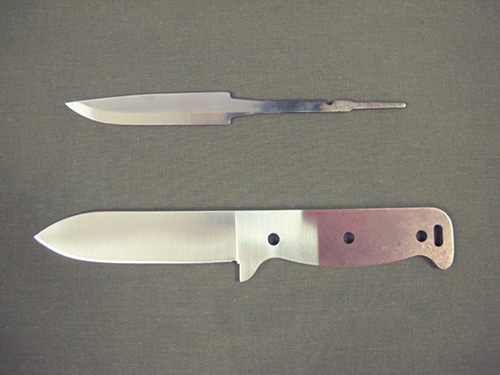
Over time, partial tang knife blades can loosen and develop “play” in the handle — especially under demanding tasks such as batoning, prying, and chopping. If a partial tang blade comes loose from the handle, it can be very difficult (and dangerous) to use effectively. In contrast, a full tang knife blade is still very functional even if the scales come off. It can be wrapped with cordage for added comfort and grip.
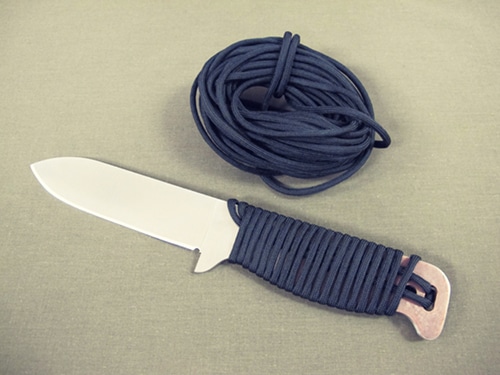
There is absolutely no advantage in choosing a partial tang blade over a full tang design for your survival knife. It’s difficult to break a solid piece of continuous metal. An easy way to spot a full tang knife is to look for the metal tang sandwiched between the knife’s scales. Below are a few examples.
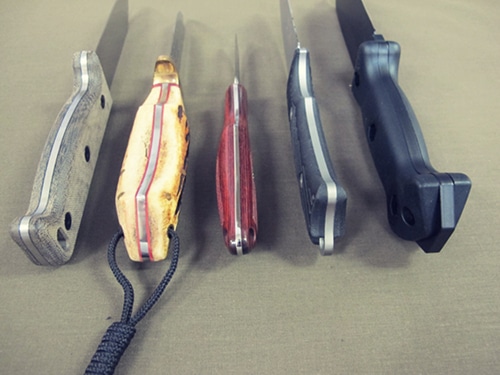
Note: Not all full tang knife blades have an exposed tang as shown in these examples.
Survival Knife Feature #4: Sharp Pointed Tip
This may seem obvious, but I’ve seen many “survival knives” with angled, rounded, hooked, or straight cut flat tips. Despite any contrary argument, there are many compelling reasons why your survival knife should have a sharp pointed tip. The first is self-defense — against man or beast. Anything other than a sharp spear point tip compromises your ability to effectively thrust or stab your knife as a weapon — especially through thick fur/hide or layered clothing.
Similarly, a spear point knife can be used as a hunting weapon — either by itself or lashed to a pole to create a longer reach spear. I keep the allen wrench (which came with my knife) in my knife sheath pocket at all times. This allows me to remove the scales and lash the full tang blade almost seamlessly onto a staff as a spear-point.


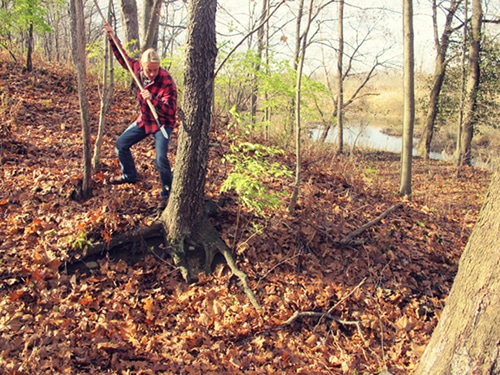
On a more practical note, I find myself using the sharp knife point for all kinds of tasks while teaching survival classes and training in the field. Below is a short list of tasks in which a sharp pointed knife tip excels over other styles:
- Detailed prying and picking
- Cleaning/dressing small game such as fish
- Drilling/notching
- Clothing/gear repairs
- Splinters!
- Processing some wild edibles such as pine nuts, acorns, walnuts, and hickory nuts
- Accessing live bait in hard to get areas
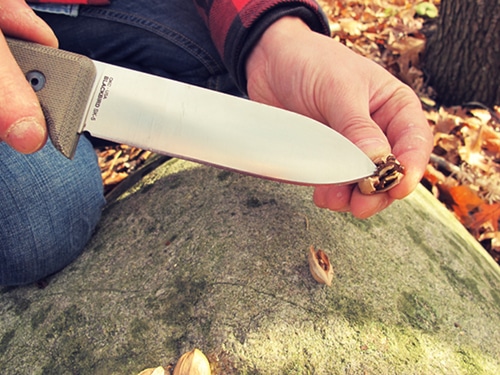
Survival Knife Feature #5: Single-Edged Blade with Flat Ground Spine
Your survival knife should not have a double-edged dagger style blade. A double-edged blade is just not necessary for the vast majority of (if not all) survival uses. Actually, it can be a disadvantage.
Not only do I recommend a single-edged blade, but I prefer for the back side (spine) of my survival knife to have a flat 90 degree grind. A flat ground spine is ideal for striking a fire-starting ferro-rod. Rounded or beveled spines make this almost impossible.
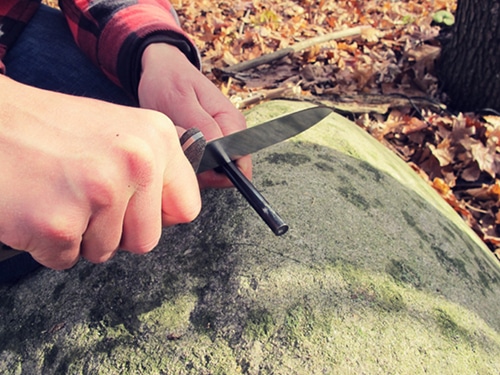
I regularly use my survival knife to baton through large pieces of wood. Whether splitting firewood or constructing makeshift shelters, a sharpened back edge would make this function nearly impossible.
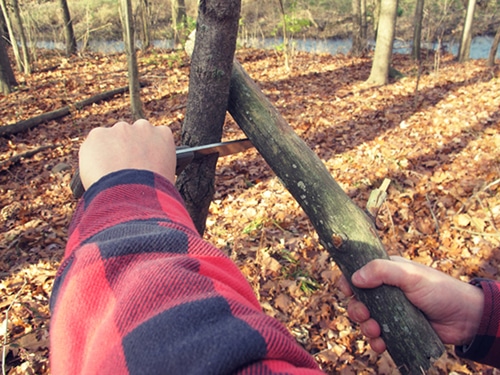
I also frequently use the back edge of my knife as a thumb rest for added leverage and control during tedious carving projects such as making feather sticks or notching triggers for traps and snare sets. Projects like this would be difficult and dangerous with a double-edged blade.
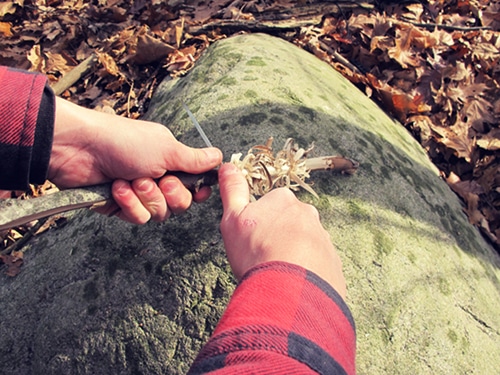
Survival Knife Feature #6: Solid Pommel
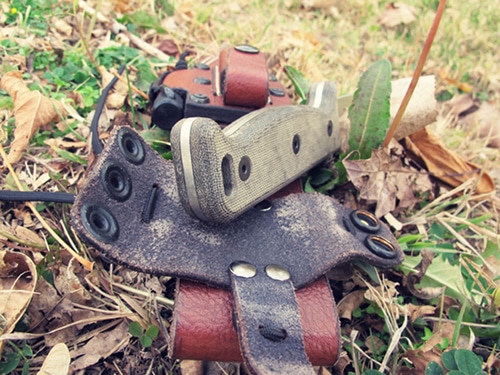
The “pommel” is the bottom of the knife’s handle — also referred to as the butt. I regularly use the pommel on my survival knife for light duty pounding and hammering. It’s perfect for driving in shelter stakes. I’ve also used my knife point to chip out crude ice fishing holes by pounding the pommel with a heavy stick to drive the blade into the ice. Some knives are designed with a rounded or hooked pommel that is not ideal for hammering. I believe in getting the most uses possible from your knife. A well-designed and substantial pommel only adds to your list of capabilities.

Bottom Line
Use the above 6 criteria as a benchmark for choosing a potential survival knife. Only you can decide the features on which you are and are not willing to compromise. Beyond this, pretty much everything else comes down to personal taste.
There are many survival knives on the market that include these 6 survival features, yet look nothing like each other. There are countless styling options that come down to personal preference and have little bearing on survival functionality. Some of these features include:
- Blade steel (carbon or stainless – varying options with varying results)
- Handle material (rubber, micarta, bone, antler, etc…)
- Color or finish
- Lanyard holes
- Decorative milling
- Jimping
- Serrated or non-serrated blade
- Sheath design and style
- Knife designer/manufacturer/brand
- Blade style
- With or without finger guards
- Blood groove
Conclusion
A survival knife is not a magic wand nor does it have inherent magical saving powers. The true value is in the skill of the one who wields it. Skill only comes from practice and repetition. You don’t buy a survival knife to decorate your man cave — it is a tool that’s meant to be used. Since the beginning of mankind, the cutting blade helped to shape how our ancestors hunted, fought, built, and survived. From cavemen with sharp rocks to a soldier in modern warfare, there will never be a relationship quite like that between a man and his blade. Choose yours wisely.
Remember, it’s not IF but WHEN,
Creek
______________________________________
Creek Stewart is a Wilderness Survival Instructor, author, and television host. To learn more about Creek, or to take classes, visit www.creekstewart.com.


